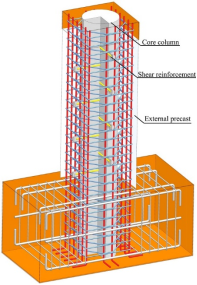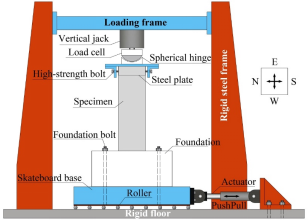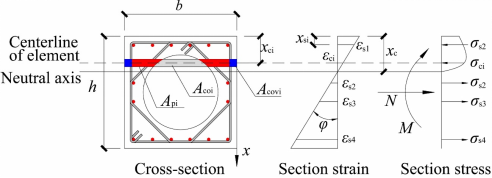To make up for the shortage of natural resources and solve the disposal problem of construction waste, the reuse of waste concrete is an effective way, i.e., crushing and sieving the waste concrete into recycled coarse aggregate (RCA). With the increase of the building height, high-strength concrete is widely used in practical engineering to reduce the self-weight of the structure. Meanwhile, the high-strength reinforcement is beneficial for matching the high-strength concrete and reducing the amount of steel.


In order to promote the application of high-strength RAC and reinforcement in precast structure; meanwhile, to solve the problems of low construction efficiency of cast-in-situ columns and poor integrity of conventional precast columns, Professor CAO Wanlin and his team from the FACTE proposed a semi-precast high-strength recycled aggregate concrete (RAC) column with high-strength reinforcement. The column was consisted of cast-in-situ core concrete surrounded by a precast external shell. To improve the shear strength of the interface between precast external shell and core column, penetrating shear reinforcement in the interface was adopted. The round holes were reserved in the precast external shell, which for venting of internal air when casting core concrete, and penetrating the shear reinforcement to increase the shear strength of the interface.

In this study, 6 full-scale high-strength RAC columns with high-strength reinforcement were fabricated and tested under cyclic lateral load, of which two were cast-in-situ columns and four were semi-precast columns. The penetration of shear reinforcement between precast external shell and cast-in-situ core column, core column diameter and axial load were the major design parameters. The test results showed that all specimens exhibited a good deformation capacity. The semi-precast columns had comparable seismic performance with the cast-in-situ columns, indicating that the penetrating shear reinforcement and the core column diameter had little effect on the seismic performance. Based on experimental results, the optimized models applicable to calculate the F-Δ curves of semi-precast high-strength RAC columns with high-strength reinforcement were proposed. Parametric analysis based on the optimized models was carried out to develop N-M curves for various precast external shell or core column concrete strength, and core column diameters. It is expected that this paper can provide the theoretical basis and data support for the further study and application of semi-precast RAC columns. The results have recently been published in the Journal of Building Engineering.
The first authors of this project are Prof. ZHANG Jianwei of BJUT. The work was done in collaboration with Prof. CAO Wanlin, ZHANG Jianwei, and DONG Hongying of FACTE BJUT.




